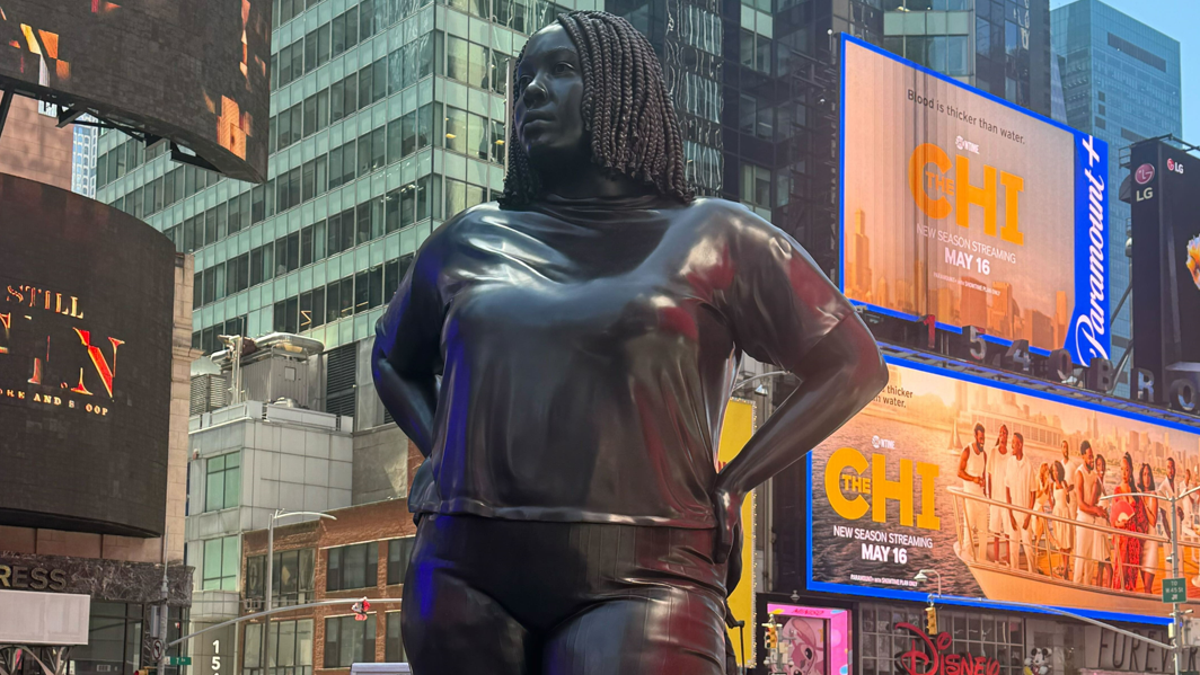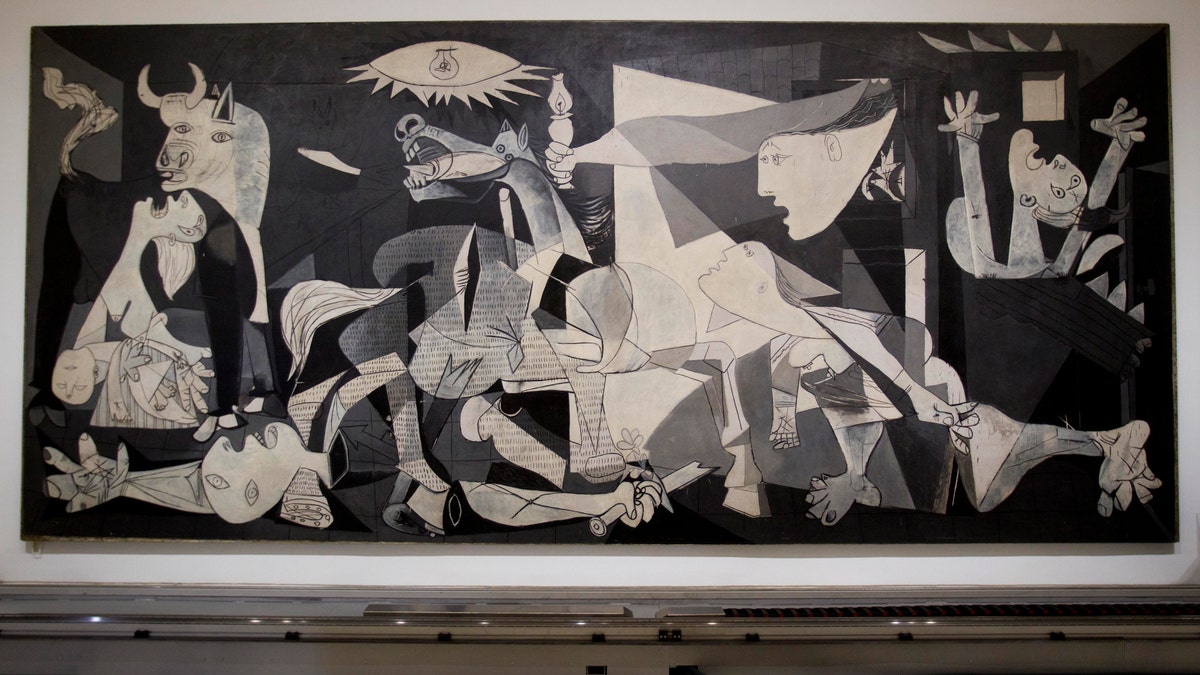newYou can listen to Fox's news articles!
For years, we have been lectured on the harmful stereotypes of angry black women and their negative impact on society, so imagine my shock when I learn that a 12-foot bronze statue of angry black women was built in Times Square.
My first thought was, “Did the white supremacists do this?”
The answer is no, but this sculpture is a physical representation of the knot with the left tied to the left, an example of how social gravity turns race, gender or sexuality into a very stereotype they reject, even if they can even make race, gender or sexuality as a whole, without knowing it.
The statue is called “grounded to the star” by artist Thomas J. Price, and depicts a heavy black woman with a braided expression saying, “You're working on my last nerve.”
Times Square promotes a new statue of a 12-foot tall black woman as a “severe contrast” with a statue of a white man
The first question about many minds is, of course, why is there a huge statue of an annoying, common black woman in Times Square? Are there any prominent black women that exist to actually celebrate? What about the giant condole the rice, or the slightly thinner Simone Biles?
Former US Secretary of State Condoleeza Rice speaks in the era of choosing a speaker series at the Ronald Reagan Presidential Library in Simi Valley, California on March 8, 2023. Rice served as Secretary of State under President George W. Bush, the second woman and the first African American woman to hold that post. Previously, she served as national security adviser under the same administration. (David McNew/Getty Images)
The answer is that this statue represents all black women. But if so, why is she wearing an accurate dour and a negative expression, and is it said we are dangerous stereotypes?
One person who can give us a clue on how to square this circle is none other than Michelle Obama, a first-lady-turned-lady podcaster who recently made the news about the subject of black women's rage.

The “Star Grounded to Star” display will be displayed in Times Square until June 17th. (Photo courtesy of Outkick)
“The label they put on us as black women is that we are mad, and the irony is, yeah, I'm probably lighter than many of my white female friends,” says Princeton University and Harvard Law alumni who have graced the covers of countless magazines.
The first thing Mrs. Obama says here is that the angry label is “put on us.” Anger is literally placed on the faces of black women, perhaps by white people, in this case, by sculptors who are black men and perhaps don't want to perpetuate harmful stereotypes.
So why does he present black women like this? It reaches part 2 of Michelle Obama's answer. In fact, being a black woman is the part she says she is either more angry or “less” than her white friends.

File – January 20, 2022: New York City workers removed part of a statue of Theodore Roosevelt, which had been standing outside the entrance to the Museum of Natural History since 1940. (Reuters/Katelyn OCHS)
What should the statue say to those who see it? It depends on who you are. If you are a black woman, you will see your own suffering and frustration. If not, you are intended to face your accomplice in that suffering and frustration.
There is a precedent for groups that claim negative stereotypes or names to be their own rebellious. A classic example is the adoption of the gay rights movement “queer.” But in this case, the goal is not to castrate or disarm the stereotype, but to inflam it.
If you take your child to see the sculpture, they may ask, “Why is she so frustrated?” You should say, “She's a black woman.”
It sounds ridiculous and offensive, but that's exactly what we're being asked to do when we incorporate this divisive work of art.
In 2022, the Museum of Natural History removed the Teddy Roosevelt statue from outside the entrance. The problem was the portrayal of an Indian and a black man walking by a Roughrider horse.
Ultimately, this sculpture is a physical representation of the knot, tied left to left. When you make race or gender or sexuality into their entire identity, without knowing it, social gravity turns it into a very stereotype they reject.
Both the men painted next to Roosevelt were his guides. They were proud, disappeared, armed, neither of them had any expressions on their faces that seemed to be working in DMV.
The statue of a proud man of color that will lead America into the future was considered aggressive and neglected, but somehow the black woman outside of the shape who appears to be angry at the cold coming out of her fly is a wonderful celebration of her people's contributions.

File – Times Square in New York City. (istock)
Ultimately, this sculpture is a physical representation of the knot, tied left to left. When you make race or gender or sexuality into their entire identity, without knowing it, social gravity turns it into a very stereotype they reject.
For more information about Fox News, click here
Public arts are sometimes said about celebrating the beauty of nature and local history, carrying the stories of great men and women, but what does this sculpture aim to do for us?
Public art can also serve as a purpose to remind us of a major tragedy. Many great works of art, such as Pablo Picasso's “Guernica,” portray intense suffering, but if there is such a message here, they do not belong under the glittering light of the crossings of the world.

File – A photograph of Pablo Picasso's “Guernica” painting is on display at the Reina Sofia Museum in Madrid. (AP2012)
Don't remember that Times Square is a place where tourists go for fun for shows and dinner, and that many black women are not seen as extremely angry for vague reasons that have something to do with privilege and systemic racism.
Click here to get the Fox News app
sufficient. This hyperfocus on race and stereotypes has been proven for 20 years by not improving race relations, making them even worse.
I am not the one who demands that the statue come down. In fact, the opposite is true, and I am not now. But if we need to have an angry black woman, can we at least get Teddy Roosevelt back?
For more information about David Marcus, click here


